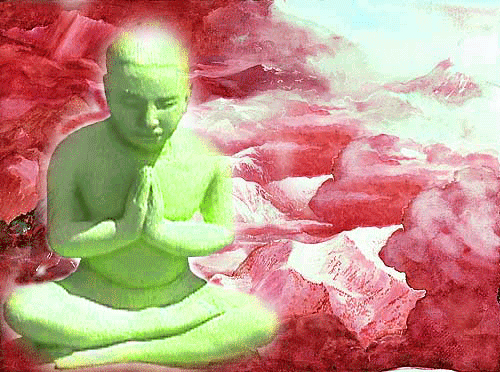————-
WHAT IS MEDITATION ?
CALM ABIDING, SHAMATHA (samatha)

“People learning the way should first empty and quiet their minds. This is because the mind must be empty before it can mystically understand the subtle principle. If the mind is not emptied, it is like a lamp in the wind, or like turbulent water, how can it reflect the myriad forms?”
Yuan-hsien (1618-1697) – Excerpted from “The Teaching of Zen” edited by Thomas Cleary
Prerequisites to achieve full-blown calm abiding:
– 1. Agreeable place: easy to obtain food without wrong livelihood, powerful place (blessed by holy persons) and quiet, not disease-ridden, proper companions and one should have heard and studied the teachings.
– 2. Have few desires in terms of food, clothes etc.
– 3. Knowing satisfaction: acceptance of what you haven and who you are.
– 4. Pure ethics: try to prevent any negative actions.
– 5. Forsaking commotion/excitement: few purposes outside meditation, reduce any other activities
– 6. Abandoning thoughts of desire and lust: contemplating faults of desire and impermanence.
As you may understand from the above, the achievement of shamatha is not a small task. It is said that if one is completely focused on the practice in solitary retreat, some people can achieve it in 6 months. There are not many people around who can claim to have mastered shamatha. To seriously engage in this practice, the advice of a teacher should be sought, and several good books have appeared on the subject.
A warning from Venerable Ajahn Chah (Pra Bhodinyana Thera):
“Samadhi is capable of bringing much harm or much benefit to the meditator, you can’t say it brings only one or the other. For one who has no wisdom it is harmful, but for one who has wisdom it can bring real benefit, it can lead him to Insight.
That which can be most harmful to the meditator is Absorption Samadhi (Jhana), the samadhi with deep, sustained calm. This samadhi brings great peace. Where there is peace, there is happiness. When there is happiness, attachment and clinging to that happiness arise. The meditator doesn’t want to contemplate anything else, he just wants to indulge in that pleasant feeling. When we have been practicing for a long time we may become adept at entering this samadhi very quickly. As soon as we start to note our meditation object, the mind enters calm, and we don’t want to come out to investigate anything. We just get stuck on that happiness. This is a danger to one who is practicing meditation.
We must use Upacara Samadhi. Here, we enter calm and then, when the mind is sufficiently calm, we come out and look at outer activity. Looking at the outside with a calm mind gives rise to wisdom. This is hard to understand, because it’s almost like ordinary thinking and imagining. When thinking is there, we may think the mind isn’t peaceful, but actually that thinking is taking place within the calm. There is contemplation but it doesn’t disturb the calm. We may bring thinking up in order to contemplate it. Here we take up the thinking to investigate it, it’s not that we are aimlessly thinking to investigate it, it’s not that we are aimlessly thinking or guessing away; it’s something that arises from a peaceful mind. This is called “awareness within calm and calm within awareness.” If it’s simply ordinary thinking and imagining, the mind won’t be peaceful, it will be disturbed. But I am not talking about ordinary thinking, this is a feeling that arises from the peaceful mind. It’s called “contemplation.” Wisdom is born right here.”
Tai Situ Rinpoche, from ‘The Third Karmapa’s Mahamudra Prayer’:
“‘The waves of gross and subtle thoughts subside in their own place.
The stream of mind rests unmoved in itself.
May we be free from the stains of agitation, stupor, and dullness,
And establish a still ocean of calm abiding’
This prayer describes the ideal state of calm abiding. In this state all gross and subtle thoughts are naturally pacified, which is to say that they are temporarily calmed down. When the mind is free from any disturbing thoughts, it becomes stable and abides in this state without there being any need for deliberate effort. In this situation two things can happen. The first is agitation (Tib. ‘jing wa’). This refers to an extroverted state in which the mind, figuratively speaking, falls into a gaze, in which it is very fascinated or ‘spaced out’. The second consists of two types of an extremely introverted state of mind, stupor and dullness (Tib. ‘mug pa’ and ‘nyog pa’). These are almost the same, though dullness is slightly more active, while under the influence of stupor one might easily fall asleep. It is a state of real blankness, while dullness is a state of extreme cloudiness that can be compared to water polluted by so much dirt that one cannot see through it.”
WHAT IS MEDITATION ?
– Introduction – Working with the Mind
– Calm Abiding, Shamatha
– Special Insight, Vipasyana
– Combining Shamatha and Vipasyana




